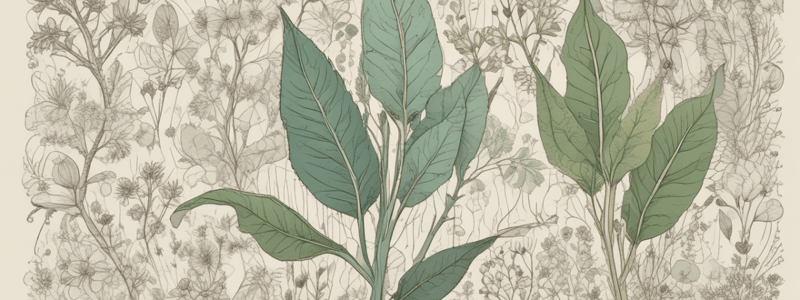Podcast
Questions and Answers
What is the primary function of roots in plants?
What is the primary function of roots in plants?
- To prevent branch formation
- To produce food through photosynthesis
- To raise leaves and flowers above ground
- To anchor the plant in the soil and absorb minerals and water (correct)
What is the main function of stems in plants?
What is the main function of stems in plants?
- To absorb minerals and water from the soil
- To produce food through photosynthesis
- To raise leaves and flowers above ground (correct)
- To store food
What is the site of food production in plants?
What is the site of food production in plants?
- Stems
- Roots
- Leaves (correct)
- Bulbs
What is the term for the area of the stem where a leaf is born?
What is the term for the area of the stem where a leaf is born?
What is the function of the petiole in a leaf?
What is the function of the petiole in a leaf?
What is the term for horizontal stems that grow underground?
What is the term for horizontal stems that grow underground?
What is the function of tubers?
What is the function of tubers?
What is apical dominance in plants?
What is apical dominance in plants?
What is the primary function of modified shoots like stolons and rhizomes?
What is the primary function of modified shoots like stolons and rhizomes?
Flashcards are hidden until you start studying
Study Notes
Plant Systems and Organs
- Plants have evolved two primary systems: subterranean root system and aerial shoot system comprising stems and leaves.
- Three main organs of plants are stems, leaves, and roots.
Roots
- Anchor the plant in the soil, providing stability.
- Store food that supports plant growth.
- Absorb minerals and water from the soil, primarily occurring near the root tips for optimal efficiency.
Shoots System
- Consists of stems and leaves, functioning as key structures for the plant.
- Stems elevate leaves and flowers above ground, which protects them from herbivores and enhances photosynthesis.
Stem Properties
- Stems may be vegetative (leaf-bearing) or reproductive (flower-bearing).
- Nodes are points on the stem where leaves emerge.
- Internodes are segments of the stem located between nodes.
- Buds represent areas for stem elongation, consisting of embryonic tissues for leaves and stems (not flowers).
Types of Buds
- Terminal bud is located at the tip of stems or branches, facilitating growth.
- Axillary bud can initiate new branches.
- Apical dominance is the phenomenon where the terminal bud suppresses branch formation.
Leaves
- Primary site for photosynthesis, converting sunlight into food for the plant.
- Petiole connects the leaf to the stem at the node.
- Blade refers to the flattened, expanded portion of the leaf, maximizing light absorption.
Modified Shoots
- Include stolons, rhizomes, tubers, and bulbs, often misidentified as roots.
- Stolons are horizontal stems that enable asexual reproduction and colonization over large areas.
- Rhizomes are also horizontal stems but grow underground.
- Tubers are specialized swollen rhizomes adapted for food storage.
- Bulbs are vertical, underground shoots, primarily comprising swollen leaf bases that store nutrients.
Studying That Suits You
Use AI to generate personalized quizzes and flashcards to suit your learning preferences.




